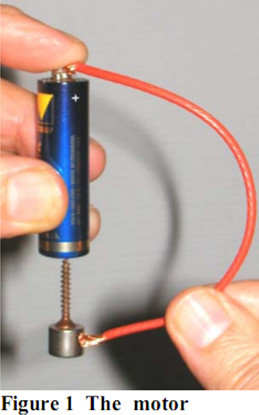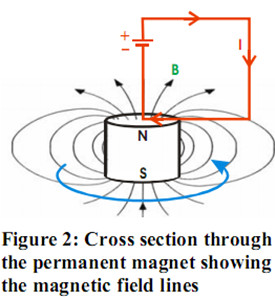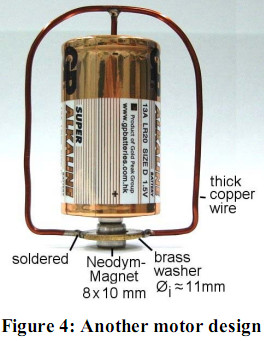




H Joachim Schlichting and Christian Ucke (English translation by Jonathan Williams)
Electrical experiments are the clearest and most exciting of those offered by physics.
Gaston Bachelard
If a combination of a cylindrical magnet and a screw is suspended from the terminal of a battery and a conducting connection is made with the other terminal, then this assembly begins to rotate. It is not only the simplest but also the fastest electrical motor to construct.
Electrical motors are mostly seen as complicated systems of coiled wire and magnets. Since one expects something complex from something complicated, one is not more surprised by the possibility to make something moving from an inanimate object. One sees surprise and fascination, not only amongst experts when, before one's eyes, a motor is assembled in a few seconds from a battery, a steel screw or nail, a cylindrical magnet and a short wire and set in rotation. The magnet, through its attractive power, attaches to the screw to make a rotor, and the screw, which has itself become magnetized, is suspended from the battery pole. Two constructive exercises are illustrated: on the one hand the magnet holds essential parts of the motor together and on the other hand it provides a low friction connection between the rotor and the battery. The bearing on the other side of the rotor is compensated by gravity which ensures that the rotor stays vertical and, due to the air bearing formed, generates the lowest possible friction. In the example in Figure 1 is used a very strong neodymium magnet (NeFeB) whose surface is chrome-plated and therefore conducts the current.


The hands provide the rest of the construction: One hand presses the end of the current carrying wire to the second battery pole whilst the thumb and finger of the other hand carefully hold the other end of the wire to the magnet providing the fine control necessary for the sliding contact.
Last, but not least, the rotor consisting of the magnet and screw provides two essential physical functions: firstly it provides the magnetic field necessary for a motor and secondly it conducts the current from one battery pole, through the wire, back to the other. Nothing more is required to convert a uni-directional magnetic attraction into a continuous movement - or put another way - to convert electrical energy to mechanical energy.
This construction has to be tried in order to believe that it really works. The differences from a tried and tested motor appear too great. This construction lacks not only the coil used to generate a second magnetic field but also the commutator which reverses the current direction at the right moment.
However, when one remembers that every current is affected by a magnetic field and that this effect is proportional to the current, the explanation becomes clearer:
The very large current which flows from the battery, through the cable, magnet and screw back to the battery must pass the magnetic field of the cylinder magnet. A Lorentz force is created which is at right angles to the current and direction of the field from the magnet. The direction of the force is given by the Right Hand Rule.
The force on the current translates into a torque which sets the cylinder magnet into rotation. The symmetry of the assembly is not affected by the rotation so a continuous rotation results.
The observation that this effect is not just a principle but leads to a remarkably fast rotation is due to the large current generated by the almost short circuit and the large field strength of the magnet. The low friction between the point of the screw and the battery and between the magnet and the lightly touching wire is also important.
The form of construction and low power of this toy means that it does not have a practical application. It demonstrates the principle of one of the oldest types of electrical motor, namely the Barlow Wheel. The Barlow Wheel was discovered by Peter Barlow (1776-1862) in 1822, before what we know of as an electric motor. It consists of a continuously flowing current and a consequent continuous motion.


Figure 3 shows an example of Barlow's construction. It consists of a rotating plate mounted at right angles to and in contact with a bath of mercury. The mercury, which is both conducting and liquid, provides a low friction connection for the rotating wheel. The wheel has a star shape in this illustration to reduce the friction further. The wheel rotates through a magnetic field produced by a horseshoe magnet. In contrast to our freehand motor, the current carrying wheel and magnet are separated. Our motor, along with Barlow's wheel, belong to an early class of Electrical motors called monopolar or unipolar.
Conclusion
The oldest principle of an electrical motor, with the help of modern materials, can be demonstrated in a few seconds using bare bands and in a clear way, illustrate the conversion of electrical energy into mechanical energy.
Addendum:
Another motor design originates from Per-Olof Nilsson from
Guangzhou Haoqing Mechanical and Electrical Equipment Co.,Ltd GuangDong M&C Electric Power Co.,Ltd
Add:Room 104, No. 8 JinXian Street, YiJing Road, Haizhu District, Guangzhou, China P.c:510080
Tel:+86-20-89660216 Fax:+86-20-89660219
http://www.china-electricmotor.com E-mail:mc@china-electricmotor.com
粤ICP备08124952号
